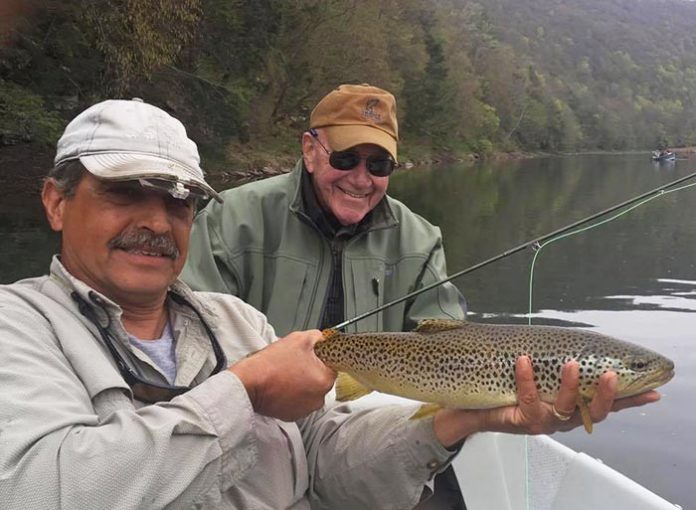Written by: Joe Demalderis, Cross Current Guide Service and Outfitters
Capt. Joe Demalderis (left) has trouble deciding on just ten patterns for fall on his home waters.
Photo via Facebook
On the Upper Delaware system, fall is a bittersweet time of year for me. Bitter in so far as the season is coming to an all too quick close; sweet because the river lights up again like a final hurrah and parting salute to a wonderful spring and summer.
Mayflies, such as Isonychia, are still hatching into and through October, along with cahills, and blue-winged olives. Caddisflies make another flurry of an appearance too. Terrestrials are sometimes the overlooked delicacy, as trout will gorge on tiny flying ants. Later dawns, earlier sunsets, and less direct sunlight as the sun shines lower in the sky contribute to keeping the water cold and the fish looking upward.
Brown trout have spawning on their mind too and become defensive of their territory. American shad fry are on the move from the tributaries to the main river and then off to the sea; in the meantime, they are a tasty meal for any fish that is bigger than them.
With all this Grade A food to choose from, and close to 80 miles of wild-trout water back on line, it’s time to tie one of mine and my guide staff’s favorite fall offerings. Here’s a list of ten flies you’ll want to have this fall on the Upper Delaware

1. EP’s Split Wing Iso (sizes 10-14)
This fly imitates an Isonychia, a mayfly that prefers to walk out of the water to hatch, similar to a stonefly. But in larger rivers, such as the Delaware they often get caught ready to crack with no shoreline in sight. So, designed to hatch from their shuck on a stationary platform, the hatching gyrations they go through in the film drive trout crazy, often with crushing takes. In this situation Isonychias twerk while thy hatch. EP’s Iso Emerger, George Schlotter’s Deer Hair Emerger and his Para Emerger are all standby patterns and favorites too.

2. Snowshoe Cahill Emerger (sizes 18-20)
These light-color mayflies are more reminiscent of the spring hatch of grey foxes and almost always bring a warm a fuzzy feeling when they show up. They also elicit nice, slurpy takes from the trout.

3. EP Blue Wing Olive Campara Dun (size 18)
Another faux-fur fly from Enrico Puglisi that just keeps on taking a licking, so we just keep on using it.

4. CDC BWO Emerger (sizes 20-24)
When it comes to the tiny stuff, from a #20 dry fly down to blue wing olives the size of a standard coffee grind, CDC is easier to see, floats well and gets eaten. Mission accomplished. You can include an RS2 in this group of flies.

5. Cannon’s Bunny Dun (sizes 20-24)
Another speck of a blue-winged olive imitation that floats well, gets eaten, and for some is easier to deal with to keep afloat than CDC.

6. Soft Hackle Hares Ear (size 18)
This piece of rabbit face is a great fly to swing through the riffles while waiting for a hatch or to use as a dropper when prospecting dry flies. Bead head or not, change it up depending on the light intensity, water depth, or flow.

7. Rusty Spinner (sizes 10-20)
Because spinners still fall.

8. Streamers
Too many meat chunks to list and keep this a Top Ten list of flies, so pick one or three patterns in white, black, yellow, and olive. Patterns like a Zoo Cougar, Drunk & Disorderly, Bunny Muddler, JC’s Sculpin, and similar.

9. Elk Wing Caddis
These fellas should be in sizes 18 and 16 in tan, sizes 16 and 18 in charcoal/grey. Add in a size 10 orangish brown caddis for the October Caddis, which starts its mostly nocturnal, sporadic hatch in September.

10. Basic Nymphs
Bugs like Pheasant Tails, Prince Nymphs, Copper Johns, and the like are all excellent fall producers. Don’t leave home without them in bead and sans-bead varieties.
In a bug buffet like the one found on the Upper Delaware, these are ten or more patterns you’ll want in your fly box this fall. Variations of each will work equally well. A poor presentation will not. If you’re confident you’ve nailed the hatch, don’t be in a rush to change flies until you are confident that you’ve also nailed the presentation. Change your angle, as even a step or two can make all the difference. Be accurate. An inch or two can be a game changer, especially on the small flies.
Lighten your tippet. On this river, if the fly size calls for 4X, I go to 5X. The way I look at it, 6X is the new 5X. With the new Super Strong tippet material, landing big fish on light tippets isn’t as big a matter of luck anymore.
In the end, enjoy the day on the river. No matter what happens, come January you’ll have another nice memory to fuel the anticipation of spring.
Joe Demalderis operates Cross Current Guide Service and Outfitters, guiding for trout and smallmouths on New York’s Upper Delaware system and for striped bass and bluefish off Northern New Jersey. He’s also a former Trout Bum of the Week.
Credit: Source link































